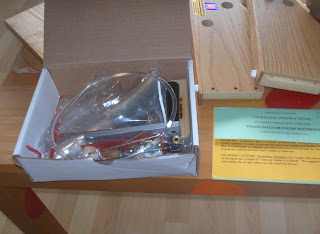What did I find? Why, I had a package! From Otto Strauch, no less!
[please, a moment of silence for the giant *SQUEEEEEEE* which erupted from my mouth]
You know that I hauled it upstairs in the elevator, and tore into it, as soon as I set everything else down.
The box itself was quite large, and weighed roughly 15-20 lb.
After tearing everything open, these were the contents of the box:

Two drums (one in cardboard), wooden pieces, a foam-wrapped bit, a smaller cardboard box, and the instructions and packing receipt.
The cardboard box held the nylon drive band, along with the batt picker, crank-handle, table clamp, and necessary screws and washers.
My first part of the review? Set-Up. Setting up the drum carder is EASY. They "tell" you to "read all the instructions before assembly". Rubbish, I say! I'm an engineer, I say! I put a car together (10 years ago), I can assemble a drum carder! (This has gotten me in trouble in the past, of course...) But, lo and behold...let me repeat: Assembly. Is. Easy.
I got this puppy built in under 30 minutes. The only thing that is still an issue is adjusting the distance between the two carder drums.
If you want a scale reference, the table my carder is sitting on is an ordinary IKEA "Lack" coffee table. The whole thing is a lot bigger than I imagined, but..having seen big ol' Pat Green carders, I realize this is pretty dang compact.
Here she is, in all her spiny glory. Keep your hands off the drums - the edges of the spines are somewhat badly machined and prickly. Especially the licker-in drum.
One very useful piece of advice Mr. Strauch gives on his instructions is to card some waste fiber through before you start carding "real" fiber. Why waste perfectly good fiber, you ask? Well, he explains that there is often machining / manufacturing dust caught in the carding cloth / on the carder drums, and that this preliminary "cleaning" with fiber will help to remove it all, so you don't turn any precious merino/ tussah blend dingy gray with metal dust! They also do not recommend carding any fiber in the grease, as the grease can clog up the carders and transfer off into other fibers. I would think if you were working in the grease, you should probably have a separate pair of hand cards or something for that purpose. While I don't mind working in the grease, I prefer to work with washed fleeces. My "waste" fiber is part of an old Lincoln lamb fleece that I bought at least three years ago (before I moved to Seattle, I know that), and is still only partially washed!
To run it through, I opened up the locks with my fingers, and then s-l-o-w-l-y fed them through the licker-in drum. The gear ratio on the Petite really slows down the carding process. You can crank all day, and it will just mosey along, picking up fiber at a leisurely rate. I guess this is for the best, though.
Here is a shot of me feeding a small amount of Lincoln lamb fleece through the carder. I'm probably just going to toss this into my "bird nest" pile, to give to my friends who are amateur birdwatchers, and like to leave piles of fluff for the birds outside their apartment.

All in all, I am looking forward to finishing off the Lincoln "practice carding", and moving on to getting into neat blends of fibers. I also have to experiment some with the doffer (?) or "knuckle saving batt picker", as Strauch calls it. It's basically a big ol' hook with a T-handle on it that you use to pull the batt off the big drum, supposedly. This might take some practice.



1 comment:
Very exciting! And nice pics. Can't wait to see what you do. Let me know if you need any dyed fibers.
(I need to find bird-watcher friends to give my fluff to. I just composted two bags of wool filled with moths. It was sad, but the fleeces were pretty rough and I decided not worth my/or anyone else's time.)
And three posts in a week! I'm impressed.
Post a Comment